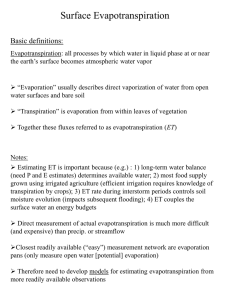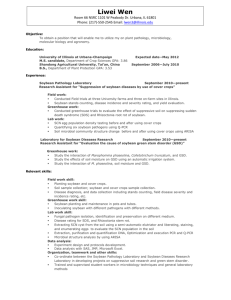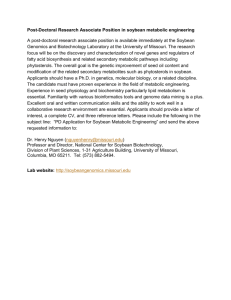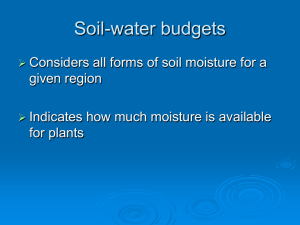The effects ofthe environmental factors on the evapo
advertisement
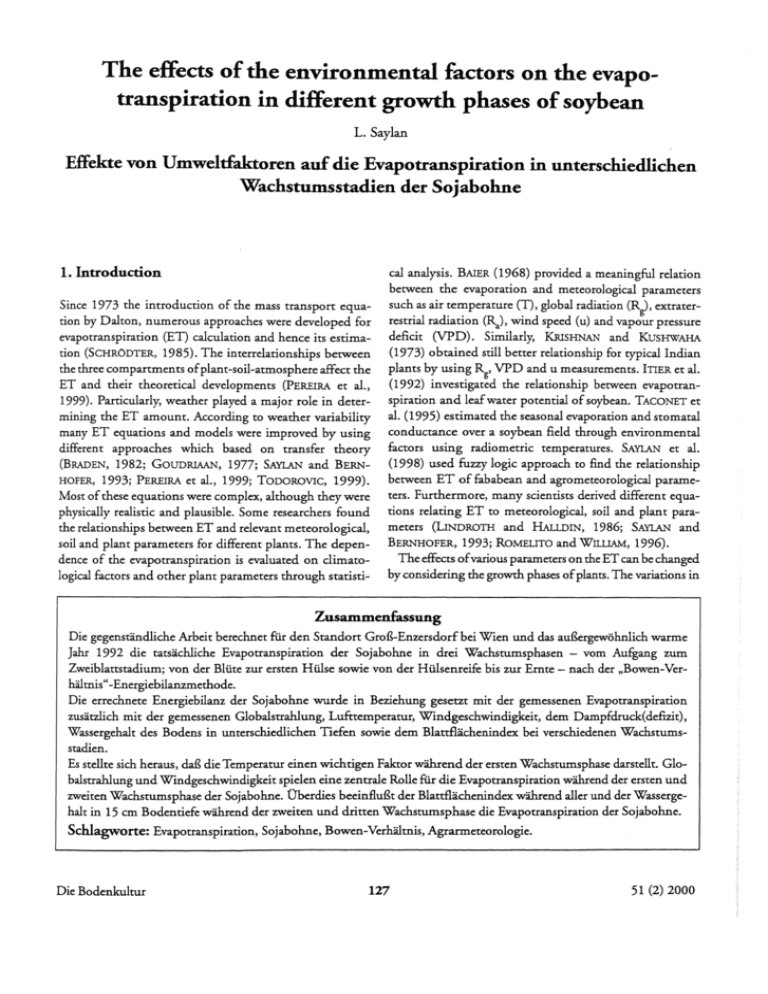
The effects of the environmental factors on the evapotranspiration in different growth phases of soybean
L. Saylan
Effekte von Umweltfaktoren auf die Evapotranspiration in unterschiedlichen
Wachstumsstadien der Sojabohne
I.Introduction
Since 1973 the introduction of the mass transport equation by Dalton, numerous approaches were developed for
evapotranspiration (ET) calculation and hence its estimation (SCHRÖDTER, 1985). The interrelationships berween
the three compartments ofplant-soil-atmosphere affect the
ET and their theoretical developments (PERElRA et al.,
1999). Particularly, weather played a major role in determining the ET amount, According to weather variability
many ET equations and models were improved by using
different approaches which based on transfer theory
(BRADEN, 1982; GOUDRIAAN, 1977; SAYLAN and BERNHOFER, 1993; PERElRA et al., 1999; TODOROVIC, 1999).
Most of these equations were complex, although they were
physically realistic and plausible. Some researchers found
the relationships between ET and relevant meteorological,
soil and plant parameters for different plants, The dependence of the evapotranspiration is evaluated on climatological factors and other plant parameters through statisti-
cal analysis. BAIER (1968) provided a meaningful relation
berween the evaporation and meteorological parameters
such as air temperature (T), global radiation (R ), extraterrestrial radiation (R), wind speed (u) and vapo~ pressure
deficit (VPD). Similarly, KRISHNAN and KUSHWAHA
(1973) obtained still better relationship for typical Indian
plants by using R g, VPD and u measurements. ITIER er al.
(1992) investigated the relationship between evapotranspiration and leaf water potential of soybeanTxcoxrrr et
al. (1995) estimated the seasonal evaporation and stomatal
conductance over a soybean field through environrnental
factors using radiornetric temperatures. SAYLAN et aL
(1998) used fuzzy logic approach to find the relationship
berween ET of fababean and agrometeorological parameters. Furthermore, many scientists derived different equations relating ET to meteorologieal, soil and plant parameters (LINDROTH and HALLDIN, 1986; SAYLAN and
BERNHOFER, 1993; ROMELITO and WILLIAM, 1996).
The effects ofvarious parameters on the ET can be changed
by considering the growth phases ofplants. The variations in
Zusammenfassung
Die gegenständliche Arbeit berechnet rur den Standort Groß-Enzersdorfbei Wien und das außergewöhnlich warme
Jahr 1992 die tatsächliche Evapotranspiration der Sojabohne in drei Wachstumsphasen - vom Aufgang zum
Zweiblattstadium; von der Blüte zur ersten Hülse sowie von der Hülsenreife bis zur Ernte - nach der "Bowen-Verhältnis" -Energiebilanzmethode.
Die errechnete Energiebilanz der Sojabohne wurde in Beziehung gesetzt mit der gemessenen Evapotranspiration
zusätzlich mit der gemessenen Globalstrahlung, Lufttemperatur, Windgeschwindigkeit, dem Dampfdruck(defizit),
Wassergehalt des Bodens in unterschiedlichen Tiefen sowie dem Blattflächenindex bei verschiedenen Wachstumsstadien.
Es stellte sich heraus, daß die Temperatur einen wichtigen Faktor während der ersten Wachstumsphase darstellt. Globalstrahlung und Windgeschwindigkeit spielen eine zentrale Rolle für die Evapotranspiration während der ersten und
zweiten Wachstumsphase der Sojabohne. Überdies beeinflußt der Blattflächenindex während aller und der Wassergehalt in 15 cm Bodentiefe während der zweiten und dritten Wachstumsphase die Evapotranspiration der Sojabohne.
Schlagworte: Evapotranspiration, Sojabohne, Bowen-Verhältnis, Agrarmeteorologie.
Die Bodenkultur
127
51 (2) 2000
Summary
In this paper the actual evapotranspiradon ofsoybean was calculated in three growth phases - from emergence to 2 nd
Ieaf, from flowering to first pod and from pod maturity to harvest- by theBowen ratio energy balance method in GrossEnzersdorf near ViennaJAustria during the extremely warm season in 1992. The estimated energy balance ofsoybean
was used to investigate the relationships between the measured evapotranspiration, in addition to the measured global radiation, air temperature, wind speed, vapour pressure deficit, soil water content in different depths, and leaf area
index under different growth phases. It was found that the air temperature is an important factor for the first growth
phase. The global radiation and the wind speed play essential roles for evapotranspiration during the first and second
growth phases of soybean. In addition, specifically the leaf area index for all growth phases and soil water content at
15 cm depth far second and third growth phases affected the evapotranspiration ofsoybean.
Key 'wordse
Evapotranspiration, soybean, bowen ratio, agrometeorology.
the plant factor like leafarea index and therefore ET depends
on the crop resisrance, weather factors, soll moisture and
developm.ent periods (PETERSCHMITI and PERRIER, 1991).
The airri of this study is to determine the relationship
arnong the pararrreters -leafarea index, global radiation, air
terrrperartare, wind speed, vapour pressure deficit and soil
warer corrterrt- with the ET ofsoybean during three growth
phases- from errrergence to 2 nd leaf from flowering to first
pad andfrom pad maturity to harvest.
2. Material and Methods
2.1 MeasureD1ents
The soybean (Go/eine max., Labrador) were planred at
Gross-Enzersdorf Experiment Station of the University of
Agricultural Sciences in Vienna (48 0 12' N; 16°34' E; 153
m above rneari sea level) during the vegetation period of
1992 ina square area of 50 m site length where the soil was
variable from the loam to the sand type (SAYlAN, 1993).. In
Gross-Enzersdorf the annual average precipitation and the
annual mean tem.peraturefrom 1953 to 1987were739 mm
and 1 0.1 0 C, respectively. The average potential evapotranspiration between 1965 and 1974 was 615 mm and
average acrual evapotranspiration berween 1969 and 1974
was 495 rnm for this research area (MüLLER, 1993).
Soybean was planted on 28 April 1992 and harvested on
2 September 1992. The total precipitation was only
340 mrn during nhe growth season ofsoybean. On the other
hand, rhe soybean was irrigated 5 times total of113 mm by
sprinkler irrigarion system. During the second and third
growth phases, the soybean was irrigated twice with the
total of 43 mm.and 35 mm, respectively:.
Die Bodenkultur
In this study, the actual ET was calculated by using
Bowen ratio energy balance (BREB) system, which was
consisted of ventilsred temperature (NiFe Resistance-thermometer) and humidity sensors that were located in different heights above the canopy. The lowest temperature and
humidity (TRH) sensors were flXedto 10 cm above canopy
during the growth phases. The difference berween the lowestTRH and the highestTRH sensors was kept 50 cm during the measurement. On the other hand, a pyradiometer
and a pyranometer were used to measure the net and the
global radiation amounts, respectively. The soil heat flux
was measured by a pair of heat flux discs at approximately
1 cm below the soil surface. The measurement of wind
speed was made at 2 m above soil surface and precipitation
was measured at 1m above the surface. The consistency of
the BREB method results were checked against criteria
given by OHMURA (1982) and evapotranspiration values
were corrected accordingly. The soil water content (SWC)
was measured by gypsum blocks at a set ofdepths as 15 cm,
30 cm, 60 cm and 100 cm, 30 minute interval and by Time
Domain Reflectometry (TDR) method 15 days interval, In
addition, crop height was measured periodically 15 days
interval duringthe growth of soybean at the site, The leaf
area index (lAI) by LI-COR lAI-2000 was measured
15 days interval also. The data were logged in every 15minnte by data logger. A detailed description ofthe site and
instrumentation were given by DIRMHIRN et al. (1991),
BERNHOFER et al. (1992) and SAYlAN (1993, 1995).
The ET was calculated temporally by BREB system in the
following three growth phases of soybean: 1st phase: from
emergence to 2 nd leaf (May 11 - May 27); 2 nd phase: from
flowering to first pod (june 25 - July 15); 3 rd phase: from
pod maturity to harvest, Quly 28 - August 30).
128
51 (2) 2000
The effects of the environmental factors on the evapotranspiradon in different growth phases of soybean
2.2 Method
only when sensible heat flux is low, around sunrise, sunset
and occasionallyat night (BRUTSAERT, 1991). The validity
of the BREB method depends critically on the similarity of
the temperature and humidity profile. According to
OHMURA (1982) due to one-dimensional steady-state
assumptions in the BREB method, and the resolution limits of the instruments, the use of gradients of temperature
and specific humidity for the ET calcularion is not always
justified. That's why this method requires certain rejection
criteria for inappropriate data,
The study is based on the Bowen Ratio Energy Balance
(BREB) method, This approach depends on the gains and
losses of the thermal energy at the evaporating surface.
Physical and biological processes in seil-plant ecosystems
control the energy and mass exchange processes (eHEN and
CHOUGHENOUR, 1994). The energy balance for evaporating surface can be written generally as:
Rn + G + H
+
L.E = 0
(1)
where Rn is net radiation (Wm-2) , G is the soil flux (Wm- 2) ,
H is the sensible heat flux in the air (Wm-2) and L.E is the
latent heat fIux (Wm-2) whieh might be further referred to
daily ET rate (mm day'").
This equation can be written by convenient definition of
Bowen ratio, b, as (BOWEN, 1926),
L.E =
(Ra + G)
(1 +
3. Results
The calculated ET values by BREB method were assumed
to refIect the actual ET and the estimations during different growth phases ofsoybean were explained below. Figures
1 a, b, c represent the measured plant and meteorological
parameters, the variations of energy balance components
and the time series of soil water content (SWC) for different depth, precipitation and irrigation values, respectively,
In Figure 1 c, it has to be noted that the number attached
to soil water content (SWC) - as for instance SWC15 shows measurement depth in cm as 15 cm. The leaf area
index (LAI) scale was shown on the right hand side verticaI
axis (see Fig. 1a). On the other hand, ~ was considered
positive when directed toward the surface, while G, Hand
LE were negative away from the surface. Although in Figures Ia, b, c, there were limited number of data as days, in
fact time multiple regression model was based on hourly
atmospheric and soil water content data.The periodically
measured LAI was extrapolated to hourly data,
(2)
ß)
where
ß=(--!:L)
L.E =
in which P is the atmospheric pressure, is E ratio ofthe molecular weight of water vapour and air, L is latent heat of
vaporisation for water, 'Y is psychometrie constant, ~ is
exchange coefficient for sensible heat, Kw exchange coefficient for water vap0 ur(KiKw= 1), er. is specific heat ofair
at constant pressure, AT and Ae are dlfferences oftemperature and vapour pressure at two heights (0.1 m and 0.6 m
above canopy surfaee) over 15-minute intervals, respectively.
The BREB method is used in determining latent heat
fluxes by many scientists (NIE et al., 1992; STEDUTO and
HSIAo, 1998; SAYlAN and EITZINGER, 1998). The BREB
method has been used extensively under wide range conditions and has shown very suceessful results, The advantage
of the BREB method is that no similarity functions is necessary for the atmospheric turbulence which appear explicitly its formulation (ÜHMURA, 1982). However, this
method requires very accurate measurements. On the other
hand, disadvantages of theBREB method are analysed by
OHMURA (1982) and PEREZ et al. (1999).
Both equations 2 and 3 produce a singularity for ß = -1,
as pointed out by ÜHMURA (1982). This oceursmore often
Die Bodenkultur
Figure 1a:
The change ofthe measured soll, plant and meteorological parameters during the three growth phases ofsoybean
Abbildung Ia: Die Änderung der gemessenen meteorologischen Bodenund Pflanzenparameterwährend der drei Wachsnuns...
phasen der Sojabohne
129
51 (2) 2000
3.1 Estimation ofsoybean evapotranspiration
In first growth phase the crop height ehanged from 2 to
15 eID. It was obvious from Figure 1a that the pattern ofT
and VPD were rather parallel to each other with ranges
13-21°C and 4.6-13.0 hpa, respeetively;. However, the
wind speed reaching to 6 m s-l. During this growth phase,
there were continuous LAI increases from almost zero to 0.9
(Figure 1a). On the other hand, energy balance components
Rn' LE and H assumed values between 168-520 W m- 2 ,
50-260 W m-2 and 35-293 W m-2 , respeetively, (see Figure
Ib). In this .phase the amount of the total ET reached
58.5 mm with average value as 3.6 mm day-l. In this early
growth phase, the soil moisture had not limitation effeet on
the soybean growth, beeause the water content in the soil
was almost at the field capacity, Figure le shows the variations of soil water content in different depth during the
three growth phases. However, during this phase LE and H
were negatively related to eaeh other beeause high LE values
correspond to low H values. Furthermore, G remains
almost constant at approximately 10 % of ~ during the
whole period.
In the second growth phase, it is possible to state from
Figure la that increases were expected in the LE due to temperature inerease up to 24 . 5° C. In addition to increase in
the VPD reaching its maximum of 17.9 hpa and eontinuous increase in the LAI during the whole period (from 2.2
to 5.3). Initially, corresponding to the increases in 1: VPD
and LAI there was a decrease in wind speed to almost
!.fJI!?;
~l; ..!.~~
-s
"S
..f ~.
':i
~'''f'
Dates
Figure 1b:
The variation of the energy balance components measured wirb the BREB system during the three growth
phases ofsoybean
Abbildung 1b: Die Variation der mit dem BREB-System ermittelten
Energiebilanzkomponenten während der drei Wachstumsphasen der Sojabohne
T)ie Bodenkultur
~
!
25
==
Q
U
20
.:!!
lIJ
~
:;
15 "0
15
e
e
lIJ
(fl
Q
Q
c:
10
10
Q
:g
~
~
.~
5
5
e
0.
O+--....--..-joooIo,....;.-;..:::=:=~~~.;...;...a,Il...!-I+~---4--+-o+-~-.:.....+--~_-'
j';i/I.:I!.$?#~
!!t;tt~
~ ~.~ ...~.;jJ
.;jJ.;jJ
R~;;~~~~ßffji
...
.:> ~ ~ "F -e "F e T' T' "f"..f
.;jJ
Dates
FigureIe:
The variation efthe soil water content (SWC), precipitation and Irrigation during the three growth phases ofsoybean
Abbildung lc: Die Variation von Bodenwassergehalt, Niederschlag und
Bewässerung während der drei Wachstumsphasen der
Sojabohne
0.7 m s·I. In the second growth phase the mean crop height
was 55 em.
In this phase, the sensible heat flux shows positive values
due to irrigation and precipitation (max, 190.2 W m-2)
espeeially along the middle range duration, which means
that the direction of the sensible heat flux was from the air
to the soil (Fig. 1b). Such an oecurrence was referred eommonlyas the "Oasis effect" (OKE, 1978). This is explained
by the fact that the atmosphere supplies sensible heat to the
surface because the surface is cooler than the regional air
due to evaporation cooling, Over this phase the amount of
total ET was reached 145.6 mm, with maximum ET value
as 12 mm per day. However, the total soil water from the
surface down to in depth of 100 cm fluctuated berween
220 mrn and 255 rnm, and consequently the plant growth
was very intensive (Fig. l c).
At the beginning of second phase, the topsoil layer had
not enough water for plant use and SWC at 15 cm varied
with the increase in crop growth. For a fully developed
green cover of soybean, although LE nearly equals Rn' hut
G and H were almost negligible apart from irrigation days.
Contrary to the first two phases, LAI decreased steadily
during the third period (july 28-August 30) where plant
heightvaried berween 70 cm and 80 cm. This phasewasvery
warm, dry and the SWC remained alrnost constant. In this
phase, there was a measuring error at lOO cm depth in the
SWC (Fig. Ic), These were indications of drought and,
therefore, the soybean field was irrigated twice in this phase.
Air Temperature and VPD values followed each other more
closely than previous phases with respective ranges of
130
51 (2) 2000
The effects of the environmental factors on the evapotranspiration in different growth phases ofsoybean
18.1° C-31.4° Cand 8.2hpa-34.0 hpa. Theaveragewind
speed was 2.6 m s-l (Table 1). Figure Ib indicates the daily
mean energy balance components that were observed in the
third growth phase which are checked according to OHMURA (1982). Rn changed between 126 W m- 2 and 595 W
m- 2 with H having often positive fluxes during this phase.
The daily mean and standard deviation (er)values ofthe meteorological, soil and plant parameters
Tabelle 1: Tagesmittel und Standardabweichung von meteorologischen,
bodenkundlichen und pflanzlichen Parametern
Table 1:
Factcrs
Coefficient of determination (?), significance test (F-test)
and error probability (P), standard deviarion (0')
Tabelle 2: Bestimmtheitsmaß (?), Signifikanztest, Irrtumswahrscheinlichkeit (P) und Standardabweichung
Table 2:
Soybean
1St Phase
Mean
0'
T (0 C)
17.41
3.38
Rg(W·m..2)
456.5
317.3
U (m.s..1)
2.41
1.87
VPD (hpa)
5.42
9.63
SWC15 (0/0)
25.01
0.83
SWC30 (0/0)
26.14
0.05
SWC60 (%)
26.42
0.06
SWCI00 (0/0) 27.16
0.05
LAI (m2.m-2)
0.48
0.23
2 nd Phase
Mean
3 rdPhase
o
Mean
In the early vegetative period (first phase), all data were
used to predict soybean L.E, whieh had a high coefficient of
determinarion with Rg only. However, still better relationship was obtained by considering four parameters, namely,
Rg, T, LAI and u for whieh the overall coeffieient of determinationwas equal to 0.82 (Tables 2 and 3). In order to
assess the validity ofthe multiple regression, BREB and L.E
values from the model were plotted on a Cartesian eoordinate system as in Figure 2a.
0'
Plant
6.41
20.42
4.91
25.61
424.5
327.0 386.0 307.0
2.61
1.54
1.85
2.57
6.22
10.19
19.72 11.21
4.29
17.23
2.51
20.26
0.0
20.81
16.55
3.43
0.0
22.09
3.81
16.55
0.0
27.54
*
*
2.68
1.42
3.61
0.81
Phases
xl
F-test
P<
er
1
2
3
0.82
0.80
0.60
160.44
154.12
21.36
0.021
0.011
0.004
29.5
61.5
79.5
Soybean
Soybean
Soybean
Regression analysis results between daily average evapotranspiration and soil, plant and meteorologica1 parameters for
three growth phases ofsoybean
Tabelle 3: Ergebnisse der Regressionsanalyse zwischen durchschnittlicher täglicher Evapotranspiration und meteorologischen,
bodenkundlichen sowie pflanzlichen Parametern ror drei
Wachstumsphasen der Sojabohne
Table 3:
* Missing value
Although before the end ofleaf (20 August) LE had values berween 100 and 484 W m..2 , later it decreased down to
25 W m-2• During this last growth phase, the influenee of
the irrigation gave rise to a positive conveetion flux from the
air to the soil.
Plant
Phases Equations
Soybean
1
LE = -305.1 + 21.6T - 0.63 Re: + 8.64u + 28.3 LAI
Soybean
2
LE = 194.9 -1.38 R - 43.1 u + 24.9 VPD
+ 10.3 SWC15 - 91.~ LAI
Soybean
3
LE = 348.2 -23.6 SWC15 - 42.5 LAI
3.2 Relationships between evapotranspiration and
various factors
The following relationships were considered for different
growth phases ofsoybean. In order to obtain appropriate relationships between LE and other parameters, stepwise which
is the most widely used of the automatie seareh methods
developed to economize on computational effons, while
arriving at a reasonably good subset of independent variables
and multiple regression analysistechniques were applied with
variables R , 1: VPD, u, lAI and SWC at a set of depths as
stated prev10usly (NETER er al., 1983). According to the partial F-test eriterion, if the variable made a signi:fi.cant contribution to the model considered, it was ineluded in the multiple regression equarion, This procedure was carried out
until P predietion errorswere less than 0.05. After takingthe
neeessary steps through a computer software strong correlations were observed betweenL.E and some of these variables.
Die Bodenkultur
-5OO~
-450
.o..-
.o..-~250
'--
i . -_ _.........J
·150
LEMooEL (W.m-2)
The relationship between calculared (L~REB) and statistically estimated L.E (L~ODEL) ofsoybean, first phase
Abbildung 2a: Die Beziehung zwischen errechneter (LEaREB) undstatistisch geschätzter LE (LEMoDEL) der Sojabohne, erste Phase
Figure 2a:
131
51 (2) 2000
In the second growth phase, the R was the most important factor for the L.E with the secongd·
srgrnificant parameter as VPD, because L.E increased in connection with VPD.
On the other hand, similar to the first measuring season
LAI and u yielded a better relationship with measured L.E.
The final important factor was the SWC at 15 cm depth,
because at the top, the soil was extremely dry and the gypsum block sensor at 15 cm depth was affected quickly by
the irrigation, the L.E and the meteorological parameters
(Tables 2 and 3). Figure 2b shows the relationship between
the model (LEMODEL) and calculated (LEBREB) hourly values.
o
-50 ~,
"
:
·150 ~
:
~E -250 ~
:.
,:
.,
;
;
··::····o:~i':~
,I"i···..'·
··.,
··~..····..·..·
·
..a5O
-500
'---_ _-'--_ _---O'
-350
lEMOOEL
-200
·50
-"-_-.J
100
(W.m-2 )
The relationship berween calculated (LEBREB) and statistically estimated L.E. (LEMODEL) of soybean,third phase
Abbildung 2c: Die Beziehung zwischen errechneter (L~REB) und statistisch geschätzter LE (LEMODEL) der Sojabohne, dritte
Phase
Figure 2c:
..
~•....;~
..:."' -: ..
;."Oi M}ftfJ'· ..:;- ·
·.. ·i~·······
;
0
.1000 L..-- _ _--'-
,
,
~
J~
-4SO ~ ..····
-550
~
,
:··Cl~·_·-jl~···· ..·:
·
;...-:;.1'c;
~:-:
·····..··..·· ·;..··
~
·..·; ·..·..· · ·:····
!
:
,· ..·..··..i
,
-6501...----....0..------'---------....0..-----'-------'
.6OQ
·500
-400
Figure 2b:
·200
-300
LEMODEl..
2
{W.m-
·100
)
The relationship berween calculated (LEaREB) and statistically estimated L.E (LEMODEL) of soybean, second
phase
Abbildung 2b: Die Beziehung zwischen errechneter (L~REB) und statistisch geschätzter LE (LEMODEL) der Sojabohne, zweite
Phase
During the last season ofsoybean, a satisfactory relationship was not observed between the soybean L.E and all the
other variables. Ir was noticed that only the LAI and the
SWC15 explained the L.E better than the other variables
because during this period LAI had coefficient of determination as ?- = 0.54 (see Fig. Zc).
4. Discussion
In this study, the influence of global radiation, air temperature, wind speed, vapour pressure deficit, soil water content in different depths, and leafarea index parameters were
investigated on the soybean ET in three different development periods.. The overall .relationship was satisfactorily
Die Bodenkultur
good because during the first period of soybean the soil
moisture was at field capacity, with no limitation on L.E.
The scatter of BREB and model L.E values appeared
around the regression modeL This implied that the model
was valid on the average without any bias, Another distinctive characteristic of this scatter diagram was that the first
period points were the closest regression to line whereas the
third period points had the greatest variability, i.e., deviations from this line were bigger (Fig 2 a, b, c), Furthermore,
during the vegetation period radiation and naturally the
temperarure increases gave rise to plant growth and LAI
value. In this connection, these parameters explained the
soybean L.E better than the other parameters during the
first growth phase. On the other hand, the SWC affected
on the ET in some phases with the crop water consumption
increase.
Particularly, the growth of soybean was related to photosynthesis increase during the second and third phases with
the radiation increase, In addition, SWC at 15 cm depth,
decreased with the plant growth and it was related to the
increase in L.E. Thus the plant root zone was very important for the L.E when the soil surface dried or the soil water
limited the rate in the L.E decrease. This was because ofthe
top layer of soil of about 15 cm was effected easily by the
atmospheric variations because of the main plant root
growth in this layer. Similarly, LAI·tended to decrease like
L.E during the third growth phase, Hence, the L.E
increased direcdy with LAI, especially, after the end leaf
attains the value of L.E as zero.
132
51 (2) 2000
It was found that R was one ofthe major parameters for
most of growth phas;s ofsoybean ET. The reason for this
was due to the radiation provided the main energy to plant
growth because of the thermal effects coupled with photosynthesis, The second important parameter was the LAI
for all periods of soybean. In this connection, the interception of radiation depends on theLAI but also on the
geometry of leaves, which had a major role for the plant
growth. The other significant parameter was the variability of soil water, which affected both plant growth and
availability of water for ET process. The temperature
affected ET during so me portions of the measuring period for plants but T might influence ET through its direct
relation to stomata,
The ET might be affected by many parameters and their
influences could vary temporally and spatially; This was the
main reason why it was necessary to find the relationships
between the ET and various parameters for different development periods of plants. If there is a limiting factor for
plant growth in a phenological period or E1: this limitation
needs to be considered in the ET estimations, The results of
this study may give the erroneous ET when applied to different cases wherein some significant parameters other then
suggested here are overlooked. The developed approach can
fail when applied to the other climatological conditions,
which varies from year to year. That's why, for generalisation of the results the weIl defined large data sets and relevant factors are needed.
schiedlicher Pflanzenbestaende. BIOMET: 9.-11. 10.
89, München, Bayr. Lw. Jahrb.. 67, 77-88.
BERNHOFER, Cn., L. W GAY, W. LAUBE and W. KLUG
(1992): Ein österreichisch-amerikanisches Bowenverhältnis-Energiebilanzmesssystem. Wetter und Leben 44,
83-106.
BOWEN, I.. S. (1926): The ratio ofheat losses by conduction
and evaporation from any water surface. Phys. Rev. 27,
771-787.
BRADEN, H. (1982): Simulationsmodell für den Wasser-,
Energie- und 5toffhaushalt in Pflanzenbeständen. Ber.
Inst, MeteoroL Klimatel. Univ, Hannover, Nr, 23, 1-49.
BRUTSAERT, W. (1991): Evaporation into the atmosphere..
D . Reidel, Dordrecht,
eHEN, D. X. and M. B. CHOUGHENOUR (1994):
GEMTM: A general model for energy and mass transfer
of land surfaces and its application at the FIFE sites,
Agric. Forest Meteor. 68, 145-171.
DIRMHIRN, I., W KLUG and W. LAUBE (1991): Eine einfache agrarmeteorologische Messetation. Wetter und
Leben. 4, 221-229.
GOUDRIAAN, J. (1977): Crop meteorology: a simulation
study, Simulation Monographs, Pudoc, Wageningen.
ITIER, B., D. FLURA, K. BELABBES, E KOSSUTH, G. RANA
and L. FIGUElREDO (1992): Relations berween relative
evapotranspiration and predawn leaf water potential in
soybean grown in severallocations. Irrig. Sei. Heidelberg,
13, 109-114.
References
KRISHNAN, A. and R. S. KUSHWAHA (1973): A multiple
regression analysis ofevaporation during the growing season of vegetation in the arid zone of India. Agric.Forest
Meteor. 12,297-307.
LINDROTH, A. and S. HALLDIN (1986): Numerical analyses
of pine forest evaporation and surface resistance.. Agric..
Forest Meteor. 38,59-79.
MüLLER, W. (1993): Agroklimatische Kennzeichung des
zentralen Marchfeldes. Beihefte zu den Jahrbüchern der
ZAMG-Klimatologie, H. 3, Wien.
NETER, J., W. WASSERMAN and M. H. KUTNER (1983):
Applied linear regression models,Irwin. Homewood, Illinois,
BAIER, ~ (1968): Relationships between soil moisture,
actual and potential evapotranspiration. Proceedings of
Hydro10gy Symposium 6, Ottawa Canada, 155-204.
BERNHOFER, Ca, and L. W. GAY (1990): Zur Abschaetzung
des Spaltöffnungswiderstandes über die Bowenverhaelrnis-Energiebilanzmethode am Beispiel zweier unter-
NIE, D., I. D. FLITCROFT and E.T. KANEMASU (1992)= Performance ofBowen ratio systems ona scope. Agric, Forest Meteor. 59, 165-181.
OHMURA, A. (1982): Objective criteria for rejecting data for
Bowen ratio fluxcalculations . J.AppL Meteor. 21,595-598.
OKE, T. R. (1978): Boundary Layer Climates. Methuen..
London.
Acknowledgments
The author wishes to thank Prof Dr, Inge Dirmhirn, Prof
Dr. Christian Bernhofer, Prof Dr. Zekai Sen, Prof Dr,
Ülgen Gülcat and Dr, J. Eitzinger for their helpful
cornments, particularly Ing. W. Laube, Ing, Wieslaw
Mikielewicz and W. Klug for technical assistance and two
anonymous reviewers,
Die Bodenkultur
133
51 (2)2000
L. Saylan
PERElRA, L. 5., A. PERRIER, R. G. ALLEN and 1. ALVES
(1999): Evapotranspiration: Concepts and future trends,
J. Irrigation and Drainage Eng. March!April, 45-51.
PEREZ, E J., F. CASTELLVI, M. IBANEZ and ]. 1. ROSELL
(1999): Assessment for reliability ofBowen ratio method
for partitioning fluxes. Agric. Forest Meteor. 97,
141-150.
PETERSCHMITT, J. M. and A. PERRIER (1991): Evapotranspiration and canopy temperature of rice and groundnut
in southeast coastal India. Crop coefficient approach and
relationship between evapotranspiration and canopy
temperature. Agric. Forest Meteor. 56, 273-298.
ROMELITO, L. L. and J. E WILLIAM (1996): Seasonal variabilities in the distribution of the micro-climatic factors
and evapotranspiration in a shortgrass steppe. Agric. Forest Meteor. 79, 113-130.
SAKAMOTO, C. M. and R H. SHAW (1967): Light distribution infield soybean canopies. Agron. J. 59,7-9.
SAYLAN, L. (1993): Der Einfluß atmosphärischer Bodenund Pflanzenparameter auf die Evapotranspiration von
Sojabohne, Pferdebohne und Mais. Dissertation Universität für Bodenkultur, Wien.
SAYLAN, L. (1995): Vergleich der BowenverhältnisEnergiebilanz- und der Eddy Korrelationsmethode zur
Bestimmung der Evapotranspiration. Bull. Tech. Univ.
Istanbul. 48, 495-505.
SAYLAN, L. and Cn. BERNHOFER (1993): Using the Penman-Monteith approach to extrapolare Soybean evapotranspiration. Theor. Appl. Climatol. 46, 241-246.
SAYLAN, L. and J. EITZINGER (1998): Estimation of the
aerodynamic and surface conductance ofa faba hean field
(Vicia faha var, Arista). Die Bodenkultur, 49 (2), 97-108.
Die Bodenkultur
SAYLAN, L, H. TATLI andZ. SEN (1998): Simulation ofagricultural meteorological factors affecting evapotranspiration by fuzzy inference. 2nd Int. Workshop on
"CAAPP '98", March 31, Budapest, 17-22.
SCHRÖDTER, H. (1985): Verdunstung - Anwendungsorientierte Messsverfahren und Bestimmungsmethoden.
Springer Verlag, Berlin.
STEDUTO, P and 1: C. HSIAO (1998): Maize canopies under
two soil water regimes. Agric. Forest Meteor. 89,
215-228.
TAcoNET, 0., A. OLIOSO, M. BEN MEHREZ and N. BRlSSON (1995): Seasonal estimation of evaporation and
stomatal conductance over a soybean field using surface
IR temperatures. Agric. Forest Meteor. 73, 321-337.
TODOROVIC, M. (1999): Single-Iayer evapotranspiration
model with variable canopy resistance. ]. oflrrigation and
Drainage Eng. Sep/Oct. 235-245.
Address of author
Assoe. Prof. Dr. Levent Saylan, Istanbul Technica! University, Aeronautics and Astronautics Faculty, Department of
Meteorology, Maslak, 80626 Istanbul, Turkey.
e-mail: saylan@itu.edu.tr
Eingelangt am 1. Juli 1999
Angenommen am 28. Dezember 1999
134
51 (2) 2000



